WARTIME, AND THE HISTORY OF THE WONDERWORKING ICON OF THE MOTHER OF GOD CALLED "THE MOUNT OF OLIVES 'SHE WHO IS QUICK TO HEAR'"
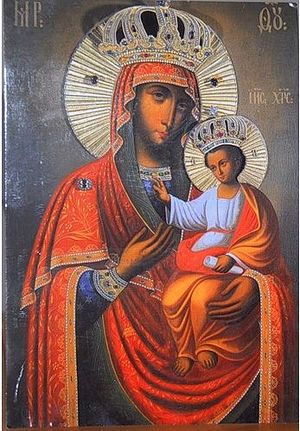 |
| Icon of the Mother of God, "Quick to Hear," Mount of Olives Convent |
At first it was not placed in the main Church of the Ascension, but instead was put up in the altar of the yet-to-be-completed refectory church, dedicated to St. Philaret the Merciful.
The sisters of the convent came to love the icon for its majestic, somewhat sad countenance, and often repaired to it when they said their prayers.
From the outset of World War I, in which Russia battled Germany and Turkey, the Russian Ecclesiastical Mission in Jerusalem (at that time under the rule of Turkey) was subjected to terrible persecution. All the clergy of the Mission and all the senior nuns were forcibly removed to Egypt. The Russian Compound and the Mission's gardens and properties in Palestine were occupied by Turkish soldiers. Monastic life on the Mount of Olives came to a halt. The nun Eupraxia, abbess of the Mount of Olives Convent, who had long been seriously ill, departed to the Lord during those disastrous times.
The sisters—young nuns and novices—remained orphaned, bereft of all help, spiritual or material. Then their eyes fell upon the icon of the Queen of Heaven and they poured forth many tears in prayer before it.
In March of 1915, a new misfortune befell the Mount of Olives and Jerusalem: a black cloud of locusts arose in the west and flew toward the east, beyond the Dead Sea. This was twice repeated. The first time, the locusts did not cause any great harm, but the plague in May was of wingless locusts. This infestation caused incalculable harm to the trees and fruits. "Millions of the creatures crawled along the ground, making a great din," wrote one of the sisters of the convent, "a clear and obvious punishment from God, the like of which none of us has ever witnessed before. Every day for a month we have struggled against the all-devouring locusts, beating and burning them."
And times became even more difficult. Without warning, the Turkish military authorities demanded that all the nuns move out to make room for soldiers to be billeted there. The Greek patriarchate, in the person of Patriarch Damianos, offered the homeless sisters lodging in several Greek-owned buildings and unoccupied monasteries in Jerusalem. The nuns accepted this offer with gratitude, but, even though they moved to Jerusalem, they closely followed what was happening to their convent. When they learned from the Arabs of the neighboring village that the soldiers were looting and removing the convent's and their own personal property, they begged the Patriarch of Jerusalem to help them.
His Beatitude the Patriarch hastened to inform the Sultan of what was happening in the Convent of the Mount of Olives, and soon the soldiers were removed on orders from the Turkish authorities, and the sisters were gradually allowed to return to their convent. Despite all material privations their spirits did not fall, for they had as their good helper the Queen of Heaven in her wondrous icon. For them, the holy icon had become "a haven and a consolation."
Finally, in November of 1918, Jerusalem was captured by the British. British soldiers were also quartered on the Mount of Olives. They lived there for a month, but helped the sisters, providing them with bread, tea, and sugar. The new government provided the sisters with work constructing a road leading to Jericho. In January of 1919, the other nuns returned to the Mount of Olives from Alexandria, and in June, the church was opened for the first time since it had been sealed in 1914. Then the nuns brought the icon into the main church of the monastery and noticed that when it was installed in its new place, the face of the Mother of God shone as with light, and her garments and those of the Divine Infant had become bright and clear.
With their meager funds and their own labors and fervor, the sisters provided a beautiful carved icono-stasis for the church, replete with gilded columns. Somewhat later, they fashioned golden crowns for the Mother of God and the Savior.
A feast day was appointed for this image, viz., the 9th of November, the day on which the Athonite wonderworking icon of the Mother of God "She Who is Quick to Hear" is commemorated.
THE COMPLETION OF THE CHURCH
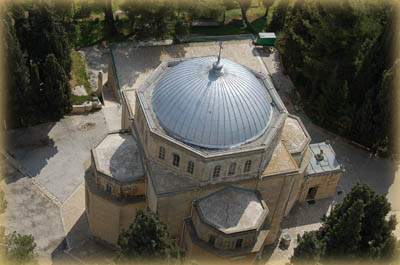 |
| The Church of the Savior's Acension today. |
Bishop Apollinarius was greeted ecstatically by the members of the Russian Ecclesiastical Mission, headed by its acting chief, Archimandrite Meletius, and sisters from the two convents (those of the Mount of Olives and Gornei) which had recently undergone so many trials.
Having regulated, to a degree, the internal life of the monastic communities, Bishop Apollinarius, however, found that he was unable to secure any improvement with regard to the Mission's property holdings in the Holy Land, and he soon left Palestine.
After this, Metropolitan Anthony himself undertook a journey to the Holy Land, in April of 1924. Thoroughly investigating all aspects of the life of the monastics, both spiritual and material, Metropolitan Anthony poured a fresh, spiritually bracing stream into the souls of the sisters who had suffered so during wartime. He made an indelible impression on the entire Russian colony, which then consisted of some 400 souls in the Holy City.
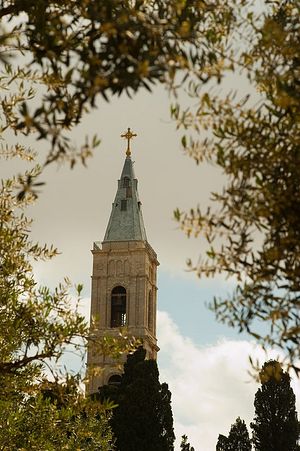
|
| The "Russian Candle" bell tower, Mount of Olives Convent |
Beginning in 1924, Archbishop Anastassy undertook the duties assigned him by the Synod. The Mount of Olives community was renamed a convent, and the mother superior, Elizabeth, was elevated to the rank of abbess and given a staff of office.
At that time, the construction of the church of the Mount of Olives was brought to a conclusion with the completion of the exonarthex, in the southern wall of which the stone was set, on which, according to tradition, the Mother of God had stood during the glorious Ascension of her Divine Son. This exonarthex was also necessary because the church could no longer hold the large number of sisters. By this time, their number had risen to about two hundred.
During this period, yet another disaster struck the convent: in 1927 a powerful earthquake shook Jerusalem and the surrounding area. The Mount of Olives sustained more damage than other places. The Church of the Ascension, the bell tower, the abbess' residence, and many of the buildings that housed the nuns were affected. Eyewitnesses say that, during the earthquake, the bell-tower swayed like a pendulum. Considerable labor was required to set matters aright, and Abbess Elizabeth of the Convent of the Mount of Olives, who after all of this fell seriously ill, considered herself incapable of carrying out this work. The appointment of a new abbess was essential, and the choice of Metropolitan Anthony fell upon the nun Paula (Kliucheva), of the Lesna Convent, whom His Beatitude knew personally. In October of 1929, Abbess Paula arrived at the Mount of Olives and assumed her duties.
Her task was not an easy one. It was first necessary to return the convent to the path of the normal monastic life, which had been interrupted by the war years. The abject poverty of the Russian Ecclesiastical Mission, now cut off from Russia, forced the sisters to go out into the world to find jobs. Many found work as domestic servants, mostly in English households. The new abbess considered it essential to bring this to an end, and to call in all the sisters working in the world. She conceived the idea of re-establishing within the convent's walls workshops for the production of ecclesiastical articles: gold embroidery, mother-of-pearl crafts, and iconography. In this way, she hoped at the same time to give foreigners and the heterodox a correct understanding of the real purpose of Russian Orthodox convents, not only in the sense of struggle in prayer, but also in that of self-denying labor. A display was organized, and it produced so powerful an impression upon those who visited it that the governor of Jerusalem offered Abbess Paula the opportunity to organize another exhibition at his gubernatorial residence in the center of Jerusalem; the offer was accepted. Thereafter, the Convent of the Mount of Olives began to receive orders from far and wide for ecclesiastical handicrafts and icons. Their objective was achieved. In this way, the funds needed for the restoration of the convent buildings were obtained. But the health of Abbess Paula declined; she began to sicken. Sensing the approach of death, she requested tonsure to the Great Schema. Her request was granted, and she received the new name Antonia.
Her successor, in 1934, was the nun Melania (Neniukova), who two years previously had arrived at the Mount of Olives Convent from Yugoslavia, on the recommendation of His Holiness, Patriarch Barnabas of Serbia, who knew her to be a wise nun, possessed of exalted spiritual qualities.
In 1936 Metropolitan Anastassy left Palestine to assume from his predecessor Metropolitan Anthony the duties of the First Hierarch of the Russian Church Abroad. From 1937 and during fourteen years thereafter the Mission was headed by Archimandrite Antony (Sinkevich),[1] the present Archbishop of Los Angeles and Southern California.
The outset of World War II marked the beginning of many difficulties for the convent. Nevertheless, in 1938 Abbess Melania undertook a major renovation of the Church of the Ascension, which had suffered considerable damage in the earthquake of 1927. It was completed only at the end of 1941. All the frescoes had to be removed; they were replaced with new ones painted by the nuns Thaisia, Zosima, and others, as well as some executed by the Russian artist G. A. Alexeyev. Weak of health and with an ailing heart, Abbess Melania reposed two years later (in 1944), and Schema-abbess Antonia was prevailed upon to return to her abbacy at the desire of the sisters and with the blessing of the bishops.
After the conclusion of World War II, a
difficult period again ensued for the Russian
Ecclesiastical Mission, and for the Mount of
Olives Convent in particular. Patriarch
Alexis[2]
arrived from Moscow <…>, and laid claim to
the Russian property in the Holy Land. This could not
fail to worry the convent. But he departed without
obtaining what he desired. Then after the United
Nations recognized the State of Israel, Palestine was
divided. Israel turned over all the Russian properties
on its territory to representatives of Moscow, and the
first Arab-Israeli War began. The Russian
Ecclesiastical Mission lost its residence building: the
Russian Compound, with the Cathedral of the Holy
Trinity, in the center of New Jerusalem. The Mount of
Olives Convent filled up with sisters who fled from the
Gornei Convent, which had found itself on territory
assigned to Israel and was taken over by people from
the Soviet Union.
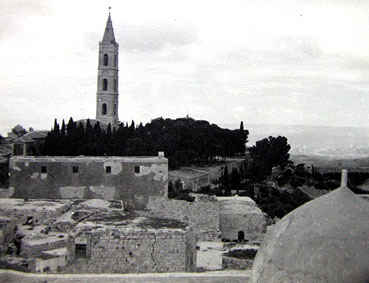
View of the monastery from the Acension chapel. 1942
Economic tribulations began again. By his hard work—pleas and petitions for help to the Mission and its inhabitants, left destitute by developments in the Holy Land, Archimandrite Antony was able to raise substantial revenues from Russian people, primarily from America. In addition, the sisters received help (in the form of food) from the International Red Cross.
In 1951 Archimandrite Demetrius (Biakai) was appointed chief of the Mission. At first he lived in the Gethsemane Convent, attached to the Church of St. Mary Magdalene; later he moved to the Mount of Olives, where he reposed in retirement on 8/21 August 1985. Thanks to his keen intellect, phenomenal memory, energy, and tact, the good relations essential for the normalization of the complex situation of the Russian Ecclesiastical Mission were established and the influx of pilgrims began once more.
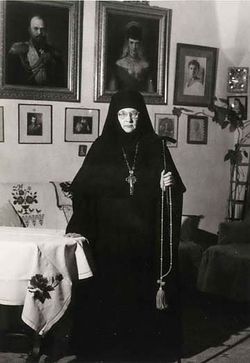
|
| Abbess Tamara |
In 1968, after the retirement of Archimandrite Demetrius, Archimandrite Anthony (Grabbe) was appointed chief of the Mission, a post he held until 1985.
From 1975 to 1984, the Convent of the Mount of Olives was governed peacefully by Abbess Theodosia. Another, less extensive restoration of the Church of the Ascension was undertaken between 1977 and 1978, during which the wall frescoes were restored by the 80-year-old nun Thaisia, with the help of other sisters.
In 1984, after the repose of Abbess Barbara of the Gethsemane Convent, Abbess Theodosia was transferred to Gethsemane. She was succeeded by her prioress, Parasceva. At the present time, forty-three nuns live in the convent.[3] Services are celebrated daily in the Church of the Ascension, with two choirs chanting antiphonally on Sundays and major feasts. <...>
This, in brief, is the history of this immense labor, which has been accomplished by the Russian faithful on the Mount of Olives. Eternal memory be to its founders, Archimandrite Antonin and Abbot Parthenius!
FromСвятой Елеонъ, The Mount of Olives Convent 1886–1986, (Jerusalem: Russian Ecclesiastical Mission in Jerusalem, 1986), 129–138. Posted on OrthoChristian.com with permission.
Nun Taisia (Ostrikova), Nun Marina (Chertkova), Vladimir Dauvaldier
* * *
Abbess Parasceva was succeeded by Abbess Juliana. Currently heading the convent is Abbess Moisseia, whose deputy is Mother Raphaela. The sisterhood is multi-national, including Russians, Palestinians, Romanians, and Estonians.



